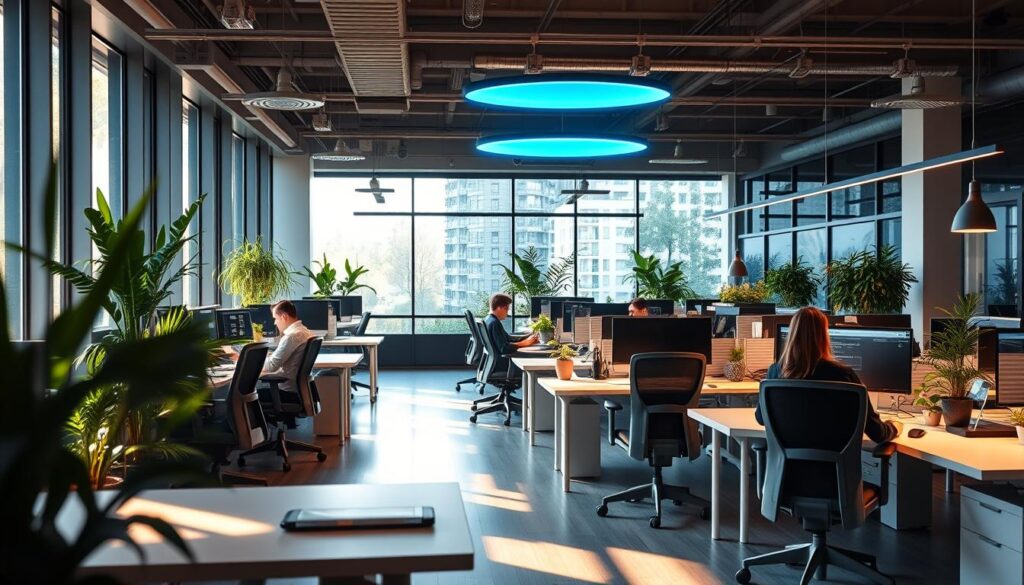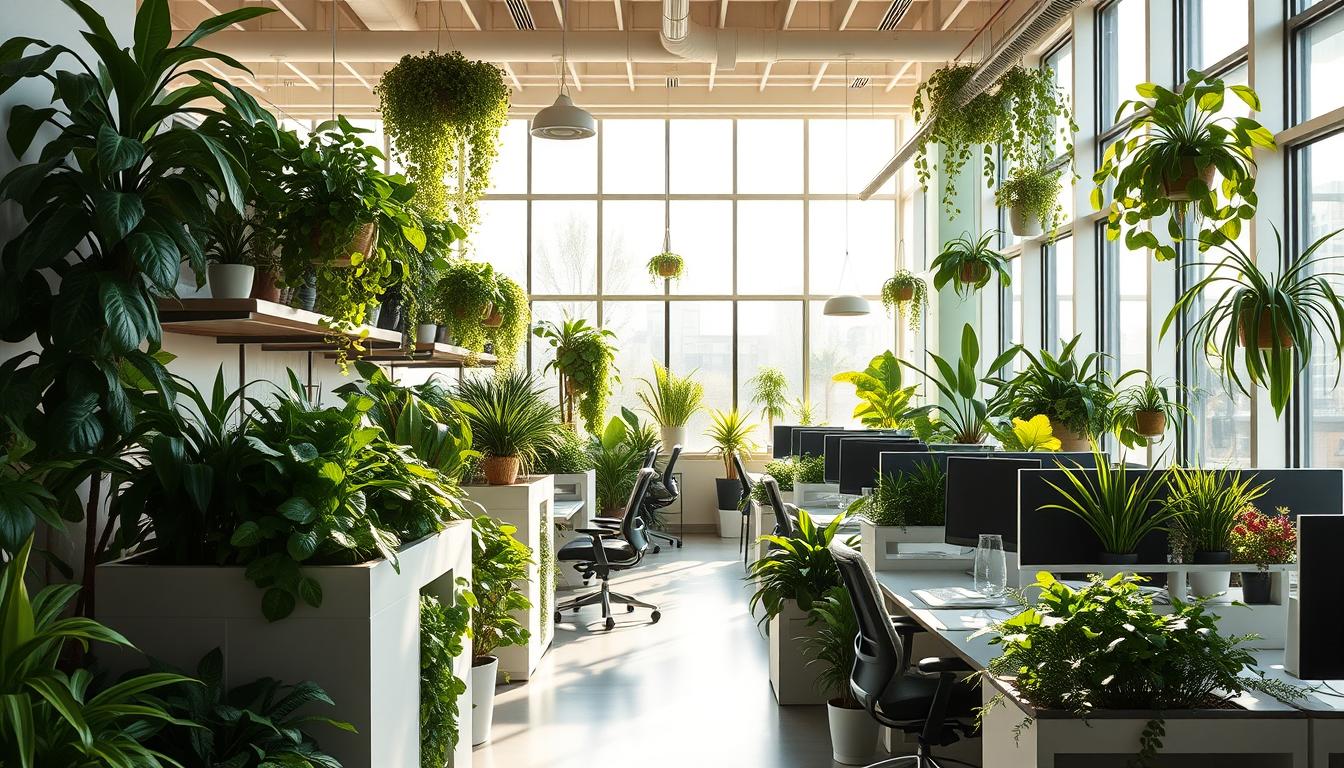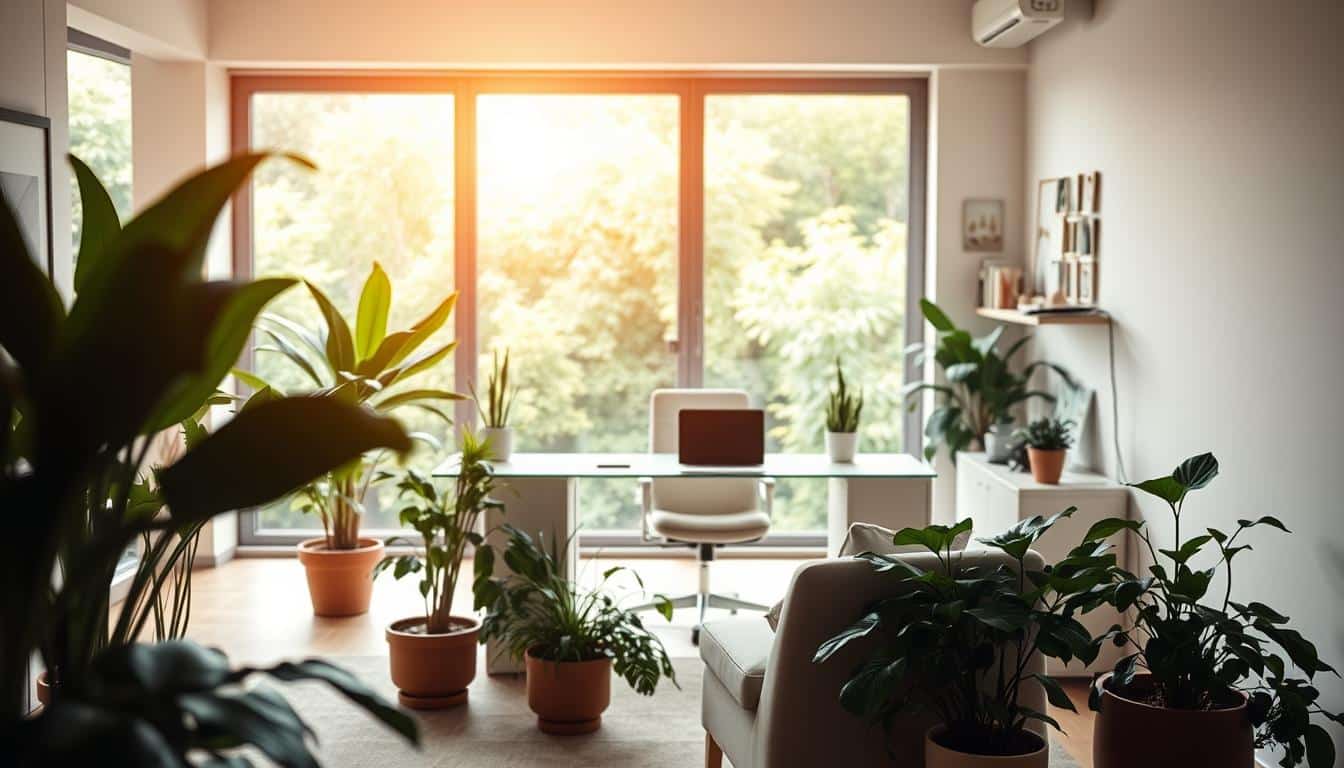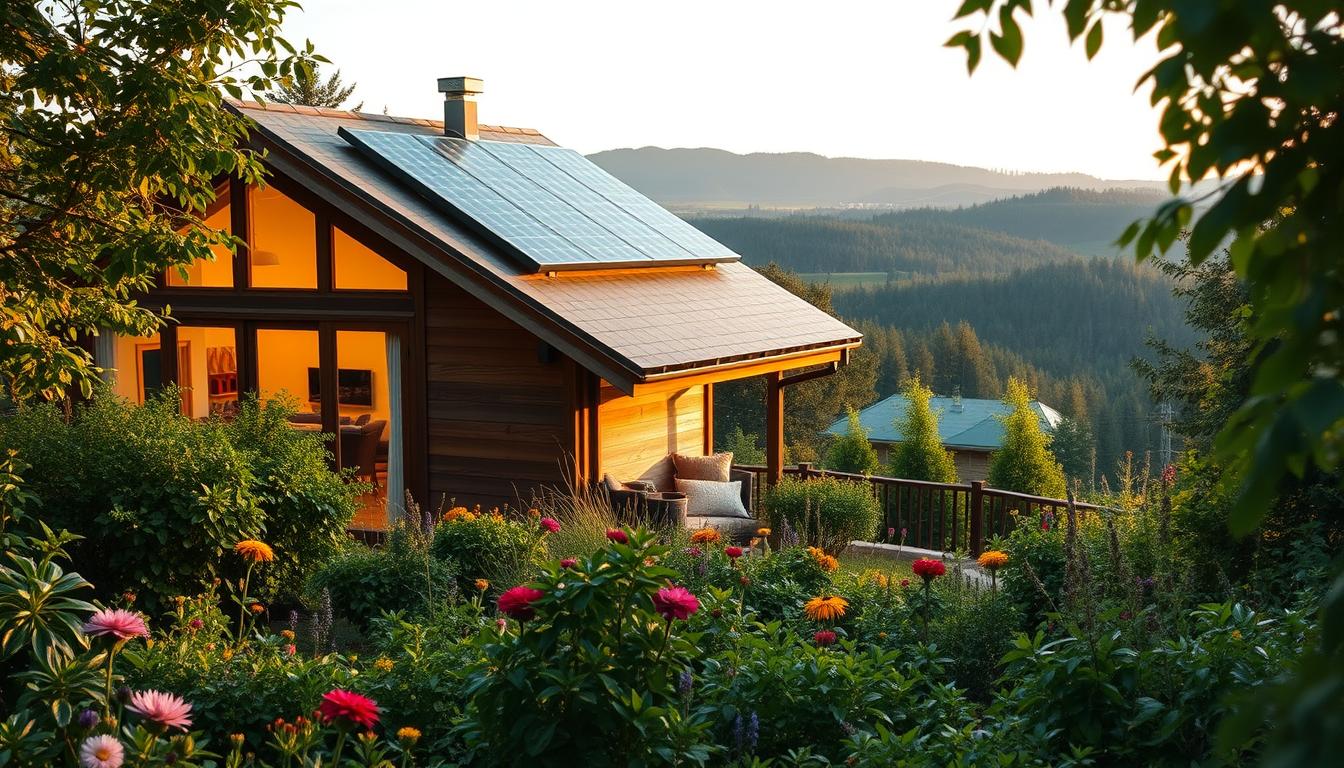In today’s world, we often overlook the combo of circadian lighting and plants indoors. Circadian lighting fits our body’s rhythms, boosting well-being. Adding plants improves our environments, creating a balanced space for better health and work. Together, they turn indoor areas into places that help us concentrate, be creative, and feel good.
The Importance of Circadian Lighting
Circadian lighting helps us match our daily routines with the natural cycle of day and night. It’s key to know how circadian rhythms guide our sleep and overall health. This knowledge boosts both wellness and work performance in different places.
Understanding Circadian Rhythms
Circadian rhythms are body processes that run on a 24-hour cycle. They affect actions like hormone release and sleep. Exposure to natural light shapes these rhythms. Using artificial light to copy these natural patterns helps our bodies function better, fighting off tiredness and stress.
Impact on Human Health and Productivity
Studies show that circadian lighting brings many health benefits. In workplaces with lighting that mimics natural rhythms, workers feel better and more awake. They think more clearly too. This creates a productive space and reduces brain drain. Companies that invest in circadian lighting boost employee health and see better performance outcomes.

What is Plant Synergy?
Plant synergy is about how indoor plants and their surroundings work together well. This link helps improve air quality and makes people feel better. Adding plants to indoor areas offers benefits for both physical comfort and mental health.
The Role of Plants in Indoor Environments
Indoor plants do a lot for indoor spaces. They clean the air by removing toxins. Plants also take in sound, making areas quieter and helping with work productivity. Having plants around can ease stress and help people concentrate better.
Benefits of Integrating Plants into Workspaces
Adding plants to work areas brings many good results. Studies show plants boost creativity and improve moods. Workers with a view of plants take fewer sick days, which increases work productivity. These benefits help individual well-being and team work.
Circadian Lighting and Plant Synergy
The way circadian lighting and plant synergy work together is key for better indoor lighting. Plants make these lighting environments better, giving many perks for plant and human health. This combination makes a space that’s not only nice to look at but also boosts health and productivity.
How Plants Enhance Lighting Conditions
Plants really help out with circadian lighting, making indoor light better. They soak up light, which helps them grow and makes the space nicer. Here’s what they can do:
- Increase humidity, which makes the air better.
- Cut down on artificial light glare.
- Clean out indoor air pollutants, making the air healthier.
When you add plants to areas with good circadian lighting, you get a cozy, welcoming place. Greenery makes tough lighting softer, leading to a workspace where you can get more done.
Reciprocal Benefits for Humans and Plants
Both people and plants win from this partnership. The right circadian lighting helps plants grow well, which makes indoors look and feel better. The main perks are:
- People working there can focus better and do more.
- Plants are healthier, which beautifies the space.
- Everyone feels less stressed and in a better mood.
Studies show that smart indoor lighting design is great for both plant growth and our health. It creates a balanced ecosystem that supports well-being and productivity.
Biophilia: Connecting Nature and Well-being
Biophilia shows our natural link to the outdoors and its perks. This idea is big in design and architecture. It’s about adding nature into buildings to make us feel good, matching our deep love for natural settings.
The Science Behind Biophilic Design
Studies prove that biophilic design is good for both mind and body. Adding plants, sunlight, and water around us makes us calm. It makes us less stressed, happier, and more content. Spaces that look like nature can really boost our health and make us work better.
Case Studies of Successful Integrations
Many places have seen the good in biophilia. Offices with plants and lots of sunlight see happier workers. The Amazon Spheres in Seattle are a great example. They have amazing green spaces that help employees enjoy their work. Schools and hospitals with natural details also show better learning and faster healing.
Designing Indoor Spaces for Optimal Lighting
Designing places with a mix of natural and LED light makes them better. Doing this helps people and plants stay healthy. It’s about getting the most light from the sun and using top-notch lights too.
Strategies for Incorporating Natural Light
Natural light is key indoors. To use it well, try these tips:
- Position windows to catch sun all day.
- Skylights brighten dark spots.
- Shiny surfaces make more light inside.
- Open designs let light move freely.
Utilizing LED Technology for Human and Plant Needs
LEDs have changed indoor lighting. They mimic natural light, helping both people and plants. Here’s how to use LED effectively:
- Changeable light for different times.
- LEDs save on energy bills.
- Smart tech adjusts light as needed.
- Lights that help plants grow.
Health Benefits of Circadian Lighting
Circadian lighting is key in boosting health and happiness indoors. It brings natural light into workplaces, helping reduce eye strain, improve sleep, and lift mood. Knowing how light affects us can make indoor spaces comfy and emotionally supportive.
Alleviating Eye Strain in Work Environments
Strong artificial lights cause discomfort and eye strain at work. Circadian lighting can ease this strain. It mimics natural light, making it easier to work without feeling tired. This results in more productivity and happiness at work.
Impact on Sleep Quality and Mental Well-being
Circadian lighting also affects life outside work. It ensures we get enough light daily, leading to better sleep. Good sleep improves health and mood. Studies show people sleeping well are happier and less stressed, creating a better work atmosphere.
Productivity Boost Through Nature and Light
Bringing plants and good lighting into work spaces can make us more productive. Bad lighting can cause work problems, like less motivation and more mistakes. Fixing lighting problems makes employees happier and more productive.
Studies on Work Dysfunction Due to Poor Lighting
Many studies have found that bad lighting leads to less productivity. Employees in poor lighting feel tired, stressed, and not connected to their work. These feelings lead to slower work and more errors. Better lighting can help workers be more focused and efficient.
Economic Benefits of Investing in Lighting and Greenery
Putting money into good lighting and plants in offices can save money over time. This comes from fewer sick days and keeping employees longer. When work places support health and work, employees do better. This leads to more work done and better earnings in a tough market.
Circadian Lighting Solutions for Indoor Gardening
Indoor gardening needs the right lighting spectrum for plants to grow well indoors. Picking the correct light type greatly aids plant growth, photosynthesis, and health. We will look at how to choose the best lighting solutions. And share tips on taking care of plants using circadian lighting methods.
Choosing the Right Spectrum for Growth
The correct lighting spectrum is key for successful indoor gardening. Plants need different light waves at each growth stage. Knowing what they need helps them grow better. Here are the main points:
- Use full-spectrum LED lights that act like natural sunlight.
- Use blue light in the growing phase for more leaves.
- Add red and far-red light to help with flowering and fruiting.
Choosing the right light mix improves photosynthesis and energy use. This makes plants healthier and more productive.
Tips for Care and Maintenance of Indoor Plants
Good plant care is more than proper lighting. Caring for the plant’s environment is key to their health. Here are some top tips:
- Keep an eye on humidity to stop root rot and mold.
- Water plants as they need, no more, no less.
- Place plants where they get plenty of the right light. Turn them sometimes so they grow evenly.
- Give plants fertilizer when needed for extra nutrients.
Using these tips can help indoor gardeners keep a healthy, beautiful garden. It makes the space look better too.
Challenges in Implementing Circadian Lighting and Plant Synergy
Mixing circadian lighting with plant synergy is tough, especially in cities. The benefits are clear, but getting there is hard because of issues. Knowing these problems is key for spaces that boost health and plant life.
Common Misconceptions About Artificial Lighting
There are many wrong ideas about artificial lighting. Some think all artificial lights help plants and people. But not all lights work the same. Also, folks often misunderstand the cost of better lighting, stopping upgrades.
Obstacles in Urban Indoor Spaces
Cities make it hard to use circadian lighting and plants together. Places with lots of buildings often lack sunlight, affecting plants and people. Money problems also limit getting the right lights. Plus, moving away from old lighting is tough. Designers and those in charge need to push for change and new methods.
Conclusion
The mix of circadian lighting and plant synergy is a game-changer for indoor spaces. It not only makes us healthier and more productive but also makes us feel good. It does this by matching with the rhythms of our bodies and our love for nature. As more research shows its benefits, it’s clear our indoor places should bring the outside in.
It’s crucial to keep creating new lighting and bringing nature indoors for better health and work. Spaces with good lighting and plants meet our deep need to be close to nature. By doing this, we make indoor areas where people want to be together and feel better.
Choosing circadian lighting and plants isn’t just about looking nice. It’s about caring for people’s experiences in buildings. The way forward is to see this blend as key to making spaces that are both useful and comforting.



